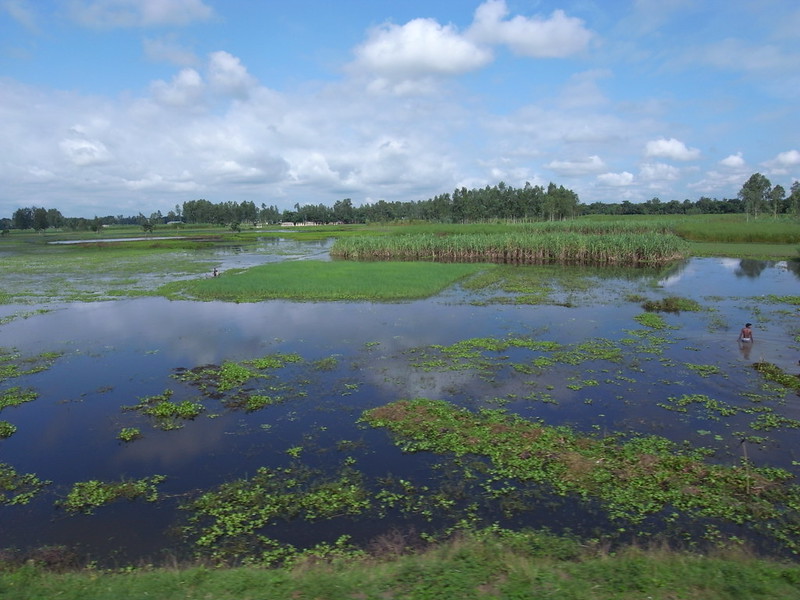Image courtesy of Claudio Napoli; CC-BY-NC-ND 2.0.
Bangladesh is currently suffering from it’s deadliest outbreak of dengue fever ever recorded.1 Between January and October 8, 2023, Bangladesh has reported 223,564 cases including 1,086 deaths from dengue.2 Before this year, the worst dengue outbreak in Bangladesh was recorded in 2019, with 101,354 confirmed cases and 164 confirmed deaths.2 Most cases and deaths this year have been recorded in the Dhaka division (124,920 cases; 786 deaths), followed by Chattogram division (32, 491 cases; 88 deaths) and the Barisal division (27,004 cases; 115 deaths).3 The death rate from this outbreak is the highest in the world, and fatalities are almost four times higher than last year, when only 281 people died from dengue.1,4 While dengue is preventable and treatable, the worsening climate crisis and fragility of Bangladesh’s healthcare system have contributed to the rapid spread and increase in deaths from the virus.
Dengue, also referred to as break-bone fever, is a preventable viral infection that is endemic to Bangladesh.1,5 Infection is caused by the dengue virus (DENV) which is transmitted to humans through the bite of infected Aedes mosquitoes.1,5 Symptoms of dengue include high fever (40°C/104°F), severe headache, pain behind the eyes, muscle and joint pains, nausea, vomiting, swollen glands, and rash.1,5 In severe cases, dengue can cause internal bleeding and death.1,5 There is no specific treatment for dengue infection, yet early detection of cases and timely access to appropriate clinical care can greatly reduce the risk for severe dengue complications and death.5
As the climate crisis worsens, countries are experiencing the heavy burden of preventable viral diseases.1 Bangladesh is vulnerable to climate devastation and extreme weather events caused by climate change including sea-level rise, increasingly powerful cyclones, high temperatures, and floods.7 In the past, dengue outbreaks in Bangladesh have been confined to densely-populated urban areas.1 This year, infections are rapidly spreading to every district across Bangladesh due to a prolonged monsoon season and rising temperatures.1,6 Higher temperatures combined with increased rainfall and humidity have lead to a rapid growth in mosquito populations across Bangladesh.2 As mosquito populations grow exponentially, mosquito-borne diseases, such as dengue, will spread farther and have a substantial impact on human health in Bangladesh.1,2
The healthcare system in Bangladesh is significantly underfunded, inaccessible, underutilized, and ill-equipped to provide adequate, equitable health services. Bangladesh has a pluralistic healthcare system that is highly decentralized and controlled by for-profit companies, NGOs, the national government, and international welfare organizations.8 This system creates unequal treatment programs and access to services across social classes in the country. Furthermore, there is a shortage of accessible physicians, specialists, and clinical equipment in Bangladesh, with quality healthcare providers strictly located in urban areas.8 While there are government-run healthcare facilities in rural areas, these facilities are underfunded and unable to support the various health needs of their communities.8 Limited government funding for health services leads to higher out-of-pocket costs that many individuals are hesitant to pay, resulting in lower rates of healthcare utilization.8
A radical change must be made to Bangladesh’s healthcare system to better support dengue patients and control the current outbreak. In August 2023, the World Bank donated $200 million (USD) to help Bangladesh improve primary healthcare services for treatment, prevention, and referral for illnesses, such as dengue.9 These funds will be partially allocated to supporting environmental health and preventive services like mosquito control, which is essential in stopping the spread of the dengue virus.9,10 Other dengue-specific interventions include introducing a climate-based dengue early warning system, outbreak response capacities, and measures to clear mosquito breeding sites.9 Improving Bangladesh’s healthcare system alone will be insufficient in ending the recent outbreak and preventing future dengue outbreaks. We must begin to address and propose interventions for the ongoing climate crisis if we wish to see a significant and long lasting reduction in outbreaks of dengue and other preventable mosquito-borne illnesses.
Sources
- https://www.cnn.com/2023/10/03/asia/bangladesh-dengue-fever-1000-deaths-intl-hnk-climate/index.html
- https://www.who.int/emergencies/disease-outbreak-news/item/2022-DON424
- https://reliefweb.int/report/bangladesh/dengue-situation-report-7-9-october-2023
- https://en.prothomalo.com/bangladesh/w6h40zxjan
- https://www.who.int/news-room/fact-sheets/detail/dengue-and-severe-dengue
- https://bdnews24.com/bangladesh/154owzvzgf
- https://www.climaterealityproject.org/blog/how-climate-crisis-impacting-bangladesh
- https://borgenproject.org/healthcare-in-bangladesh/#:~:text=7%20Facts%20About%20Healthcare%20in%20Bangladesh%201%20Bangladesh,inequality%20affects%20healthcare%20in%20Bangladesh.%20…%20More%20items
- https://www.worldbank.org/en/news/press-release/2023/08/30/world-bank-helps-bangladesh-improve-primary-healthcare-in-cities
- https://news.un.org/en/story/2023/08/1139692


